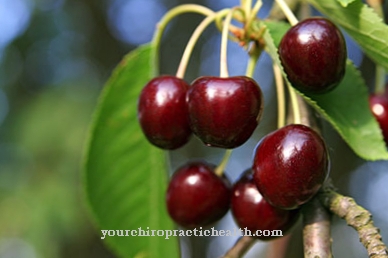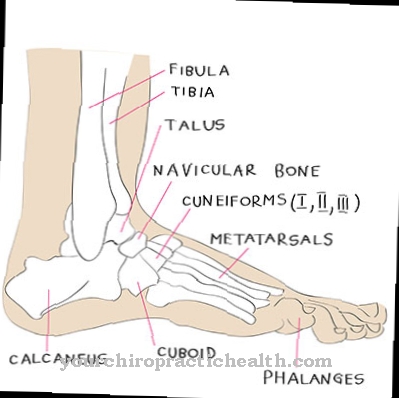The Paramyotonia congenita belongs to the form of myotonia, which is characterized by long-lasting states of tension in the muscles. It is a genetic disease in which the function of the sodium channels is disturbed. The symptoms only occur when the muscles cool down or after prolonged physical activity and are barely or barely noticeable when it is warm.
What is Paramyotonia congenita?

© adimas - stock.adobe.com
The Paramyotonia congenita is a disease of the muscle function, which manifests itself in long-lasting tension after muscle contraction or exposure to cold. This disease was first described by the neurologist Albert Eulenberg, who lived from 1840 to 1917. For this reason, the Paramyotonia congenita is also called Owl Mountain Disease designated.
In contrast to the other myotonia such as Myotonia congenita Thomsen and Myotonia congenita Becker, it is not a chloride channel myotonia, but a sodium channel myotonia. So here there is a disruption of the sodium ion transport. Sodium ions flow into the cell to generate the action potential. After muscle contraction, these are normally immediately transported out of the cell until a membrane resting potential has developed.
In Paramyotonia congenita, this process is delayed and can take several hours. Mainly when exposed to the cold or after prolonged muscle strain, the tension in the muscles is difficult to relieve. In contrast to the chloride channel myotonia, the muscles stiffen even more when moving. The voluntary muscles are particularly affected by this disease.
causes
Point mutations on the gene SCN4A, which is located on chromosome 17, have been identified as the cause of Paramyotonia congenita. As a result of these mutations, the function of the sodium channel in the muscle cells is severely impaired. Sodium ions flow into the cell to develop the action potential. In the resting potential state, however, the sodium ion concentration is greater outside the cell than inside.
This means that there is a higher potassium ion concentration within the cell than the sodium ion concentration. The resting potential is actively created by the ion pump function of the sodium channel. If the process of restoring the resting potential from the action potential is disturbed, a long-lasting state of tension in the muscles occurs. This is called myotonia because the muscle tone remains elevated for a long time.
In Paramyotonia congenita, the influx of sodium ions into the cell is promoted, especially when exposed to cold and muscle contraction. Two causes for the development of a particularly high potential for action are discussed. Some of the disorders are likely due to the sodium channels no longer closing. Another part of sodium channel myotonia is based on the delayed occlusion of the sodium channels.
With further exposure to the cold or continued physical activity, the potential for action continues to build up. Only when it is warm and in a state of rest is the resting potential slowly built up again. However, this is in contrast to the chloride ion channel myotonia, in which the resting potential is built up during physical activity.
Symptoms, ailments & signs
Paramyotonia congenita exists from birth, with the symptoms remaining unchanged throughout life. Eyelid muscles, eye muscles, face, neck and lower and upper extremities are particularly affected. For example, a closed eyelid cannot be opened for hours when exposed to the cold.
A cold effect already exists when a damp and cool washcloth is applied. In addition, the patient's face stiffens like a mask when exposed to the cold. At the same time it comes to movement restrictions, whereby the fingers have a painless flexion position. Paradoxically, the stiffness increases with repeated movements and exposure to cold.
After prolonged exercise and exposure to cold, muscle weakness then occurs. Some patients also suffer from periodic hyperkalemic paralysis after puberty. When it is warm, there are usually no or only minor symptoms.
Diagnosis & course of disease
Myotonia congenita can already be diagnosed by the symptoms that occur. The differential diagnosis between the individual forms of myotonia is also simple. While the chloride ion channel myotonia Myotonia congenita Thomsen and Myotonia congenita Becker show almost identical symptoms, they can be clearly differentiated from Paramyotonia congenita.
A simple examination method is the application of cold compresses to trigger the lid myotonia. After that, it is impossible for those affected to open their eyelids for a long time. At the same time, the patients see double images, which should always be asked about in the anamnesis. The increasing stiffness with repeated movement also suggests sodium channel myotonia.
The high levels of creatinine kinase typical of muscle diseases are found in the blood. However, since these values also occur in other diseases, they are irrelevant for the diagnosis.However, a genetic test can fully confirm the diagnosis.
Complications
With proper treatment of Paramyotonia congenita, there are no complications. Life expectancy is not reduced. However, the major challenge, especially in winter, is to avoid cooling of the joints. In summer, the joints stiffen when you go swimming, among other things. This leads to the stiffening of the joints and general physical weakness. The same applies to longer physical work.
However, cooling cannot be completely avoided. That would only be achievable if those affected were constantly staying in rooms with a higher temperature. Some patients also suffer psychologically from the fact that they can only carry out many leisure activities to a limited extent. In individual cases this can even lead to mental illness and depression. As a rule, no drug treatment is necessary for Paramyotonia congenita.
Just avoiding the joints cooling down is sufficient in most cases to prevent stiffening. In a few cases, however, the symptoms can be so severe that treatment with the drug mexiletine is recommended. However, treatment with this drug, which is actually used for cardiac arrhythmias, should only be used in exceptional cases, as it can lead to various side effects. When taking it, dizziness, mood swings, visual disturbances or nausea are often noticeable. In very rare cases, thrombocytopenia with increased bleeding tendency can occur.
When should you go to the doctor?
Disorders of the muscular system are a sign of a health impairment. They should be clarified by a doctor so that a treatment and therapy plan can be drawn up. The first indications appear already in the first days or months of life. If muscle stiffness occurs during exposure to the cold or intense physical activity, a visit to a doctor is advisable. If the solidification persists for several hours, this is an indication of Paramyotonia congenita. If the joints move, the stiffness increases even further.
The symptoms of the genetic disease remain constant for life without medical care and do not increase in intensity. Disorders of movement, a firm flexion of the joints and paralysis should be examined by a doctor. The disease is characterized by freedom from symptoms under warm environmental conditions. If there are irritations in coping with everyday life or if sporting or professional activities cannot be carried out as desired, a doctor is required.
An increased risk of falls or accidents, unsteady gait and fear should be discussed with a doctor. If the physical limitations show emotional problems or mental disorders at the same time, the complaints must be clarified. If the person concerned complains of changes in vision while the muscles are stiff, action is required. Double vision is often documented during the phase.
Therapy & Treatment
A causal treatment of Paramyotonia congenita is not possible because it is a genetic disease. In most cases, however, no treatment is necessary if the effects of cold and prolonged physical activity are avoided. No reliable data are available on drug treatment.
However, to resolve a long-lasting stiffening, the use of the drug mexiletine is recommended. Since this medication is a cardiac drug, watch out for any side effects.
You can find your medication here
➔ Medicines for muscle painOutlook & forecast
The disease called Paramyotonia congenita is characterized by over-excitability of the skeletal muscles. This leads to involuntary muscle contractions. However, life expectancy is not restricted. The prognosis for Paramyotonia congenita is therefore positive. The hereditary disease, which occurs relatively rarely, is inherited as an autosomal dominant trait.
The affected person's muscles involuntarily cramp. It can only be relaxed again with great difficulty. Tension and relaxation when climbing stairs are difficult. People affected by Paramyotonia congenita experience problems especially when exposed to the cold or after sitting for a long time. They can be difficult to walk, grasp, or balance. Because of the involuntary muscular cramps, they are more at risk of falling than others.
Despite the Paramyotonia congenita, there is no muscle weakness. Those affected may well have an athletic build. The constantly contracting muscles create a kind of training effect. The symptoms are improved through targeted training. The aim of this is to undo the relaxation disorder and to weaken its effect. Most of the time it works pretty well. The attending physicians therefore rarely consider a short-term drug therapy.
A cure for Paramyotonia congenita is currently not possible. The disease is already established in childhood. It remains lifelong. Those affected can have an increased risk of respiratory illnesses or respiratory paralysis due to myopathies if they need intensive medical treatment.
prevention
A prevention against Paramyotonia congenita is not possible due to its genetic cause. However, in the case of an existing illness, extensive freedom from symptoms can be achieved if a few rules are observed. It is important to avoid the effects of cold, bathing in cool water and prolonged physical activity. However, since the connection between these influences and the symptoms is obvious, those affected will essentially adhere to these rules.
Aftercare
In many cases, those affected with Paramyotonia congenita have only limited follow-up measures available. First and foremost, a quick and, above all, an early diagnosis should be made so that there are no further complications or other complaints for the person concerned. The earlier a doctor is consulted, the better the further course of the disease usually is, so that the person affected should ideally see a doctor at the first signs and symptoms of the disease.
Most patients with Paramyotonia congenita are dependent on the measures of physiotherapy and physiotherapy. Many of the exercises from these therapies can also be performed in your own home in order to increase the mobility of the body again. In many cases, Paramyotonia congenita is treated by taking various drugs.
The person concerned should always on a regular and the prescribed intake in order to alleviate the symptoms properly. If anything is unclear or if you have any questions, you should always consult a doctor first. A doctor should be consulted first, even if there are severe side effects. Paramyotonia congenita may also reduce the life expectancy of the person affected.
You can do that yourself
Patients with Paramyotonia congenita are very sensitive to cold. To avoid myotonic reactions occurring, you must therefore keep your muscles warm. It is therefore important to avoid the cold, especially in the winter months. Warm clothes and heated rooms are essential in the cold season. There are also some challenges in summer, because the characteristic muscle tension also occurs in a cold bathing lake. In everyday life, even cold tap water can lead to paralysis in the face.
Depending on how severe the symptoms are, your doctor may recommend drug treatment. It is important to ensure the correct dosage here. Medicines help alleviate the problem, but they also have side effects. When people know the cause of their sudden muscle stiffness, they learn to deal with it. For example, those affected warm the washcloth before using it and wait until the water is warm before putting their hands under the open tap.
The tension in the muscles can be increased by physical activity. Therefore, too much exercise is not recommended for patients. In the case of stiffness, it helps to act quickly and warm up the affected parts of the body.





.jpg)







.jpg)

.jpg)
.jpg)











.jpg)